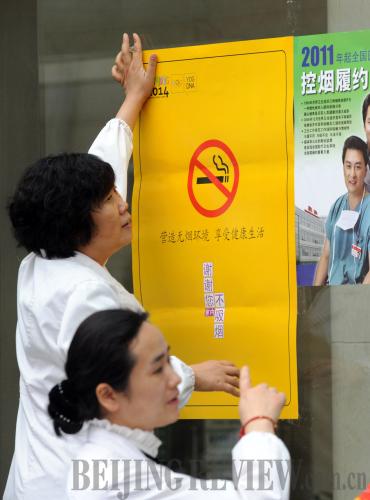|
 |
|
RAISING AWARENESS: Doctors display a poster emphasizing the smoking ban at the No.1 Hospital in Nanjing, Jiangsu Province, on May 31, 2013 (SUN CAN) |
Among the many things in the world at which China ranks number one, there is none more notorious than the number of smokers within its borders. The number of Chinese smokers totals at 300 million, roughly equivalent to the U.S. population, and one third of the global smoking population. The prevalence of smoking as a habit leaves at least 740 million non-smokers regularly exposed to secondhand smoke and 1.4 million Chinese die from smoking-related diseases every year on the mainland.
With a determination to reduce the number of smokers, the Chinese authorities have begun to require officials around the country to set a good example so as to support its tobacco-control campaign.
According to a circular released on December 29 last year by the Communist Party of China Central Committee and the State Council, China's cabinet, Party and government officials are not allowed to smoke in schools, hospitals, sports venues, on public transport vehicles, or any other public place where smoking is banned.
The circular also bans government functionaries from smoking or offering cigarettes to others at work or during other official activities, including meetings and business dinners.
Other requirements include: The sale of tobacco products and advertisements will no longer be allowed in Party and government offices; and prominent notices announcing smoking bans must be displayed in meeting rooms, reception offices, passageways, cafeterias and rest rooms.
Yang Gonghuan, a professor at Peking Union Medical College and former Deputy Director of the Chinese Center for Disease Control and Prevention, believes that the circular is a landmark in the country's journey toward an effective tobacco-control system.
"The circular can be regarded as a political commitment made by central authorities. Such a vow regarding tobacco control is unprecedented," Yang said.
An opportunity
According to statistics from the Chinese Association on Tobacco Control, 61 percent of male Party and government officials in the country are habitual smokers, and 52.7 percent of them say that they have never attempted quitting.
In response to the latest smoking ban, an anonymous official from central China's Henan Province was quoted by Beijing Times as saying that "the policy should not be implemented hastily," as exchanging cigarettes has for a long time been considered standard practice among officials.
Despite the skepticism, the National Health and Family Planning Commission has vowed to build a smoke-free social environment with intensified tobacco control advertising and health education that will help raise social awareness about the harm tobacco causes.
On January 1, 2014, Mao Qun'an, the commission's spokesman said that health and family planning authorities will coordinate with other government departments to promote legislation for tobacco control.
Li Tong, a county official in southeast China's Fujian Province, said that the effect of the circular is already being felt. "It was habit to exchange cigarettes before a meeting began, and meeting rooms used to be full of smoke when officials gathered. But now, top county leaders have taken the lead in putting out cigarettes before entering meeting rooms, and other participants have followed," Li said.
Similar progress has also been reported in other places.
In Nanchang, central China's Jiangxi Province, organizers of the local legislative session, which was held on January 8-12, displayed about 20 posters emphasizing the smoking ban in meeting rooms, lobbies, corridors and rest areas. The posters were put up to remind participants, many of them local officials, not to light up, said Wu Xincai, an official with the Standing Committee of the Nanchang Municipal People's Congress, the city's legislature.
Reportedly, leading officials in Pudong New Area of Shanghai signed documents pledging to take the lead in banning cigarettes and have also organized a supervision team including more than 20 average residents, mostly retired, to supervise enforcement of the smoking ban. The supervisors are permitted to report any violation of the ban directly to the head of the Pudong New Area Government.
"Officials at all levels should take the lead in adhering to the smoking ban," said Wang Ke'an, Director of the ThinkTank Research Center for Health Development, a Beijing-based anti-smoking advocacy group, adding that good examples set by officials could help with the overall tobacco control in China.
| 